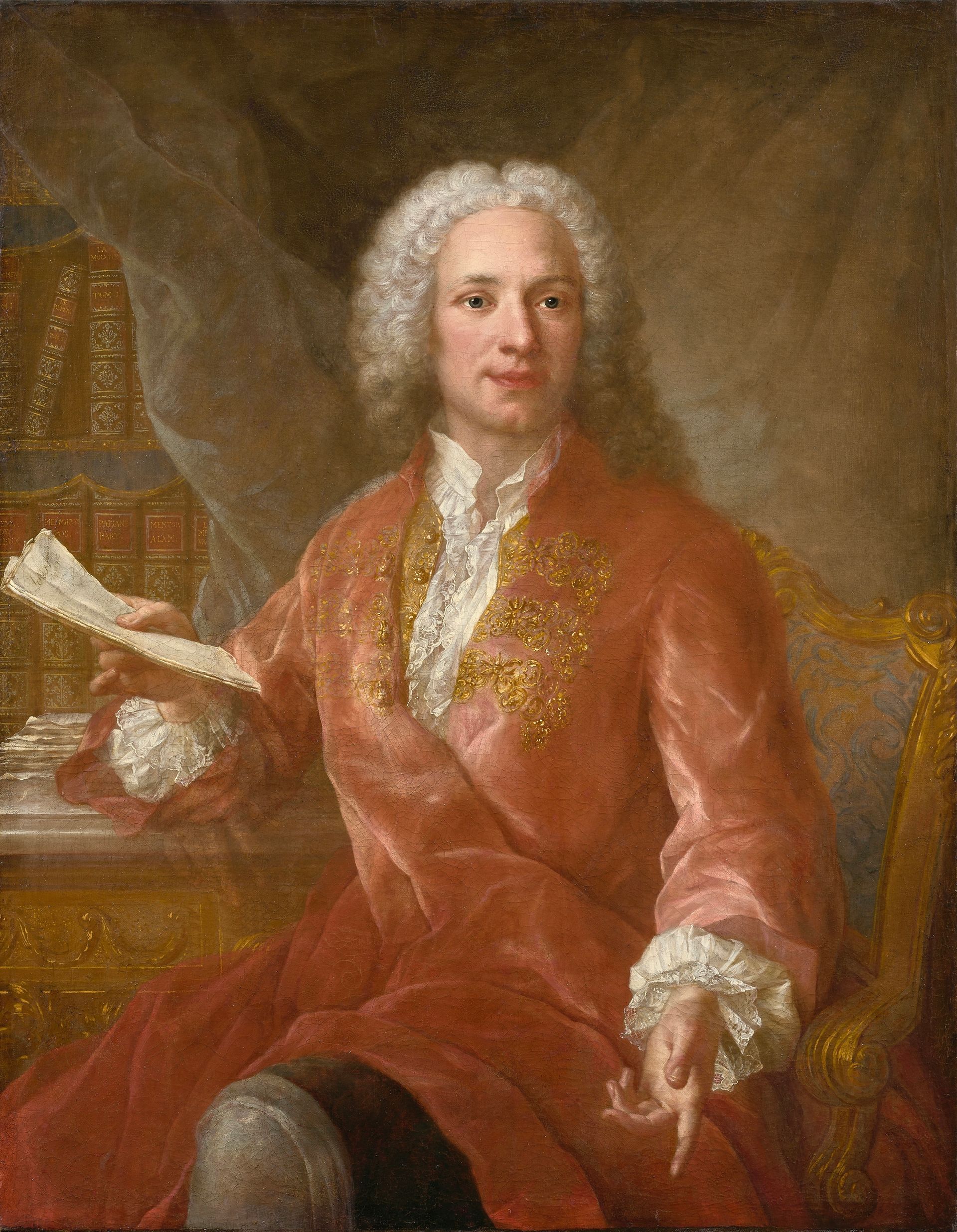
Nicolas LANCRET (Fontainebleau 1690 – 1743 Paris)
circa 1730
Portrait of Charles de Fieux, chevalier de Mouhy (Metz 1701-1784 Paris)
Worn signature on the letter: “La.c”.
Oil on canvas, 100.5 x 80 cm
Model's name inscribed on reverse of canvas and stretcher
PROVENANCE
- Nice, Private collection until July 2024
THE MODEL
The identity of the model is given on the reverse of the canvas and stretcher, inscriptions probably brought back by a restorer when the work was relined. This is confirmed by the 1737 engraving of Charles de Fieux at the age of 36 (Latinville Pinx. Et Fessart Scul.) (fig.1). The print shows an older model, with a clearly recognizable nose, mouth and chin, but also a forehead, so there's no contradiction, as the inscription on the back of the painting corresponds to the model's correct identity.
FIG.1.
Our painted portrait reveals a younger man than the model in the engraving, so we can estimate Charles de Fieux's age at around 30 years, which would put the painting's approximate date of execution at around 1730.
Charles de Fieux, chevalier de Mouhy (Metz 1701-1784 Paris), was a prolific novelist as well as a journalist involved in Parisian literary life. He collaborated with Voltaire (1694-1778) and was involved in the publication of periodicals such as Le Papillon (fig.2) (Journal des dames, des Salons, des Arts, de la Littérature, des Théâtres, et des Modes), as well as Le Répertoire, which he founded in 1735, the same year Lancret was appointed advisor to the Académie on March 24, 1735, a periodical containing Parisian anecdotes and literary criticism. In 1736, he entered Voltaire's service, sending him “news by hand”[i] from Paris, supporting his plays, following his trials and, occasionally, acting as his prête-nom. On April 25, 1741, Chevalier de Mouhy was locked up in the Bastille for publishing Mille et une faveurs sans permission[ii] (Contes de Cour, tirés de l'ancien gaulois, par la Reine de Navarre, 4 tomes), a transgression by Mouhy, who slipped easily from gallantry to bawdiness, the author masking erotic scenes with euphemism. His works include novels such as La Paysanne parvenue and La Mouche, as well as works on theater history, such as Tablettes dramatiques and Abrégé de l'histoire du Théâtre-Français.
FIG.2.
Nicolas Lancret (1690-1743) was a renowned painter, a pupil of Antoine Watteau and a member of the Académie royale de peinture et de sculpture, renowned for his scènes galantes and his depictions of worldly life, a pictorial genre that blends elegance, sensuality and theatrical staging. His works were destined to adorn private residences, as well as theaters and reception halls. His paintings were part of the frivolous, theatrical Rococo decor that dominated the visual culture of his time. In some of his works, Lancret not only alludes to the theater, but also depicts theatrical scenes, such as open-air performances, dances and plays. In this way, he documented a form of theatrical life typical of the 18th-century aristocracy, with whom he enjoyed great popularity. Nicolas Lancret's link with the theater is essential to understanding his style and the times in which he lived. Like Watteau, he drew much of his inspiration from Commedia dell'arte, the Italian theatrical form popular in the 17th and 18th centuries.
It's easy to imagine how Nicolas Lancret and Charles de Fieux might have been linked. The Chevalier Mouhy wrote about the theater and society of his time, while Lancret painted similar scenes. Their respective fields, literature and painting, are culturally interconnected - with Voltaire we're also talking about men of the same generation - and should make it possible to retrieve further information over time, making Mouhy painted by Lancret all the more meaningful.
THE WORK
The signature on our portrait, present on the letter held in the model's right hand, was correctly identified by a scientific study[iii]. A few letters made more distinct under the digital microscope were enough to identify and partially reconstruct Lancret's name.
Evidence of portrait painting by Nicolas LANCRET is rare: a pair of small-format paintings (fig.4 & fig.5) (canvas, 41.3 x 33.3 cm & 39 x 31cm), Portraits de Mr. et Mme. Gaignat, are in the Fogg Art Museum, University of Harvard.
The very free manner in which our work is painted, we note a certain rapidity of execution, evidenced by the pentimento of the model's right hand initially resting on the edge of the console, but also another pentimento of red drapery around the waist (fig.3 detail), is comparable to that of another work by the artist; for comparisons with Lancret's Portrait de famille sur fond de paysage (canvas, 74.3 x 93.4 cm, former Wildenstein Collection), painted with a similar technique, see the index finger of the man's left hand in full transparency beneath the drapery.
FIG.3. Detail.
The artist's Self-portrait, canvas, 89 x 72 cm (Ader-Tajan sale, 7 Nov 1991, lot 76), probably painted in the years 1715/1720, deserves to be cited in this notice as it represents a beautiful testimony to the art of portraiture by Lancret. The model was famous, subsequently engraved by sculptors such as Ch. Courtry and M. Aubert.
[i] François Moureau, Directory of Handwritten News. Dictionary of the Clandestine Handwritten Press, Oxford, Voltaire Foundation, 1999.
[ii] Charles de Fieux de Mouhy[archive] on the Dictionary of Journalists (1600-1789).
[iii] Art in Lab report from March 10, 2025
DETAIL PHOTOGRAPHS











